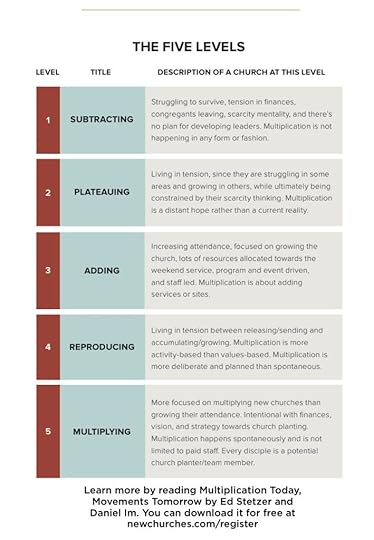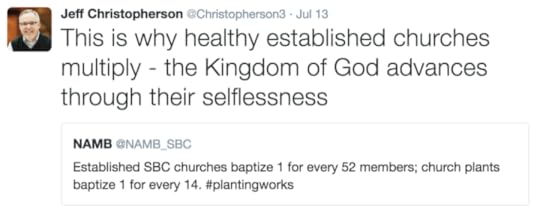Daniel Im's Blog, page 21
December 6, 2016
Questions to Find Your Calling

“If time and money were no object, what would you do with your life?”
I forget who first asked me that question, but when they did, it was a defining moment for me. Well, it eventually became a defining moment for me. In the moment, it was just plain annoying.
I didn’t want to do the hard work of thinking. I wanted someone just to tell me what my plot in life was. I wanted someone to tell me what I was good at, so that I could just do that, and be done with it. I wanted to copy what made others successful, hoping that following their paths would do the same for me.
—— Enter the giveaway at the bottom of this article for a chance to win one of four copies of More: Find Your Personal Calling and Live Life to the Fullest Measure ——
Boy, am I ever glad someone asked me that question. It’s what has partially catapulted me down the road to where I am today and the deep honor and privilege I have to serve pastors and church leaders.
I often return to what Sun Tzu, the Chinese general, military strategist, and author of The Art of War wrote. Let me paraphrase him,
If you know your enemy, you’ll win half of the battles. But when you know yourself, you’ll win the other half. [1]
Just imagine the implications if we spent as much time discovering the unique ways that God has wired, gifted, talented, and called us, as we do reading biographies, copying the “successful,” and mimicking models? Investing in yourself is time never wasted.
Investing in yourself is time never wasted.
Click To Tweet
The Power of the Right Questions
I love what Peter Drucker wrote about the importance of questions,
Answers are important; you need answers before you need action. But the most important thing is to ask…questions.
In order to find your calling in life, take a moment and prayerfully answer the following questions from my friend Todd Wilson’s new book, More: Find Your Personal Calling and Live Life to the Fullest Measure:
Am I willing to move and go wherever God wants me to go?
Am I willing to work with whomever God wants me to work?
Am I willing to go whenever God asks me to go?
Am I willing to do whatever God asks me to do, regardless of consequences?
How can I expect God to send me and use me if I’m not really willing to go? [2]
BE-DO-GO Framework
In More, Todd provides a timely framework to help us discover our personal callings and the unique impact that God is preparing us to make. This framework is broken down into three questions:
“What am I created to BE? (a design or identity question)
“What am I created to DO? (a purpose or mission question)
“Where am I created to GO?” (a compatibility or position question)
These three questions are then divided into two categories: our primary calling and secondary one.
Our “primary calling is to be disciples who make disciples where we are!” Our secondary calling is our unique calling—“the unique, divine equipping God gives each believer to help carry the fullness of Jesus to the world.” This calling is, in the cofounder of Yale University Cotton Mather’s words, a “certain particular employment, by which [a person’s] usefulness in his neighborhood is distinguished.”[4]
Do you know your calling(s) in life?
Are you clear on your primary calling? If so, do you know your secondary calling? In More, Todd Wilson acts as your guide to help you discover both. Be sure to pick up a copy here, and click the button below to enter into a draw to win one of four copies of More: Find Your Personal Calling and Live Life to the Fullest Measure.
Before we end, let me list ten of my favorite quotes about calling from this book:
Trust deeply the author of your story
Click To Tweet
Step forward in faith, even when you cannot see clearly
Click To Tweet
Abandon the earthbound kingdom of me in order to gladly serve in the eternal kingdom of God
Click To Tweet
Submit to the lordship of Jesus
Click To Tweet
Embrace your mission to carry the fullness of Jesus to every corner of society
Click To Tweet
Live in common with a healthy, local community of faith
Click To Tweet
Take personal responsibility of the unique role Jesus gives you
Click To Tweet
Trust the guidance and power of the Holy Spirit
Click To Tweet
Be disciples of Jesus who make disciples where you are
Click To Tweet
Fulfill your unique personal calling to play your role in God’s mission
Click To Tweet
Next Steps:
Pick up a copy of More: Find Your Personal Calling and Live Life to the Fullest Measure.
Enter the draw to win one of four free copies of the book before January 5.
Click here to learn more about this book, download an excerpt, and get additional resources.
End Notes:
[1] Sun Tzu, The Art of War, trans. Lionel Giles (England: Allandale Online Publishing, 2000), 11.
[2] Todd Wilson, More: Find Your Personal Calling and Live Life to the Fullest Measure (Grand Rapids: Zondervan, 2016), 72-73.
[3] Ibid., 89.
[4] Ibid., 91.
[5] Ibid., 212.

November 29, 2016
The Musical Art of Leadership

You may not be aware of this, but I’m actually a classically trained violinist.
No, this is not what I do for a living, but it’s what I did for over a decade growing up. In fact, the capstone to my “musical” career was to play Max Bruch’s Violin Concerto no. 1 in G minor with a full orchestra accompanying me (that’s a picture of me during that concert). You can listen to it here (no, this is not me performing it, it’s Itzhak Perlman, one of my violin heroes.)
In fact, I never thought I’d get the chance to actually hear him live, but it happened! He came to Nashville and it was worth every penny. He’s a living legend.
Have you ever considered the relationship between music and leadership?
In a TED Talk from 2008, Benjamin Zander, the conductor of the Boston Philharmonic, discusses the relationship that music has with effective leadership.
You can watch it here, but let me share a few of my thoughts and reactions on the musical art of leadership, based on his talk:
While you might learn the stuff of leadership in a book, seminar, or classroom, the art of leadership can only be learned overtime through sweat, tears, and practice.
Rather than trying to rationally convince people they need what you’re offering, figure out a way to awaken , within them, a desire for it,
The best leaders focus on making other people powerful, rather than themselves.
When people aren’t following, you need to ask yourself, “Who am I being that others aren’t being inspired?”
Leaders awaken possibility in others, rather than use others to awaken their own possibility.
The art of leadership can only be learned overtime through sweat, tears, and practice.
Click To Tweet
The best leaders focus on making other people powerful, rather than themselves.
Click To Tweet
Leaders awaken possibility in others, rather than use others to awaken their own possibility.
Click To Tweet

November 22, 2016
Church Planting! Is it for you?

The question, “Am I called to be a church planter?” is not a straightforward one. It’s not like, “Should I breathe?” or “Should I love others as Jesus does?”
The question, “Am I called to be a church planter?” is kind of like asking, “Should I go into an Arts program, Science Program, or a Trade Program?” What’s implied behind this question is the importance of further education. So the question is more a matter of, “Which route will you take?”
Or it’s like the question, “Should I eat a pop-tart for breakfast?” Yes, obviously you need to eat food, but if you eat a pop-tart for breakfast, how is that going to affect what you eat for lunch? And how will you deal with the sugar crash and belly rumblings mid-morning?
When we look at the biblical commandment to “Go, therefore, and make disciples of all nations,” the natural outflow of that is the planting of new churches.
We see this through the Early Church and how the apostles preached the gospel, made disciples, and planted churches that then preached the gospel, made disciples, and planted churches. I mean, just look through the book of Acts! And then look at how the New Testament was written to new churches in their respective life situations. Essentially, the New Testament can be seen as an anthology of church plants. The fact is, just like we all need to eat food or we will die, we need to all be about church planting, or the church will die.
We need to all be about church planting, or the church will die.
Click To Tweet
So the better question that we need to answer is, “Am I called to be about church planting?”
And let me make this easy for you. If you’re a follower of Christ, the answer is a default yes.
Now there are people who will object to church planting and will say things like,
“Isn’t one larger church better than a lot of smaller churches?” Well, the fact is, it’s not an either/or. Both are good and necessary, but according to our recent State of Church Planting research, we discovered that new church plants are extremely effective at winning people to Christ. So while there isn’t anything wrong with larger churches, there is definitely something wrong if we don’t plant new ones!
“We have enough churches!” Based on the census data from 2011, there are 11 churches for every 10,000 Americans. Now unless, there are mega churches in every neighborhood in this country, there simply aren’t enough churches. Add that to the fact that our population continues to increase, and the numbers speak for themselves.
We all need to be about church planting.
But the next question we have to ask ourselves is, “Am I called to be a church planter?” That question is a bit more complex.
In the second edition of Planting Missional Churches, we walked through a few of the characteristics of Paul, the church planter, throughout the New Testament. Here’s a few of his characteristics:
He was an evangelist (Acts 9:19-22)
He was entrepreneurial (Rom. 15:20-23)
He empowered other leaders (Titus 1:5)
He cared for people (Acts 20:17-21)
He stayed committed to his calling despite the sacrifice (Acts 16:25)
How many of those characteristics do you identify with? It’s not enough to just be excited about the idea of planting a church, being the boss, and not having to do ministry the way others do. Planting a church is much more nuanced than that. If those are the types of reasons that are pushing you to plant, you will fail, the enemy will have his way, and the cumulative aftermath will be devastating.
Planting a church is not just about being the boss!
Click To Tweet
So who is the ideal church planter? What does a church planter look like?
There certainly isn’t one type of church planter, since there isn’t just one type of church. Depending upon the model you choose, and the context that you plant in, the type of planter will differ.
However, regardless of model and context, the fact is that every planter and pastor needs to first put themselves up against the biblical qualifications as outlined in passages like 1 Timothy 3. For example, planters need to be above reproach, able to teach, self-controlled, not lovers of money, and so on. Be sure to read through this passage and put yourself up against it.
There certainly isn’t one type of church planter, since there isn’t just one type of church.
Click To Tweet
In addition to that list, there are a few other indicators that will give you a glimpse into whether or not God is calling you to be a church planter:
1) Starter. Do you have a pattern of starting things? Lemonade stands, Bible studies, compassion-based ministries, and the like? Are they still around after you’ve left? You will be doing this over and over again in planting.
2) Equipper. Do you always have to be the one doing the work of ministry? Or can you lead and equip others to do the work of ministry? How about leading others who lead others? This is our task as church leaders and pastors—to be equippers, not doers as we read in Ephesians 4:11-13. Without this, your church will never break the 50 barrier or grow beyond your personal leadership lid.
3) Dreamer. Do you long to make a greater impact and change this world? Do you see the world in a different way? Can you help people catch that vision? This hunger and drive is critical for church planters.
4) Doer. No I’m not contradicting myself from point two. Instead, I’m asking, Do you execute, follow through, and get things done? There are many pastors, church planters, and visionaries who love the dreaming stage so much that they can’t actually get things done.
If you see those four indicators in your life, God may be calling you to plant. If you see some, but not others, perhaps this is the best time to develop those competencies.
Now what if you said yes to all four of those indicators?
Well, you need to ask yourself a few qualifier questions:
1) Do I have a burden and a calling to specifically plant a church? In your time with God, is this something that God continues to bring up? I’m not asking if you’re interested in the idea. I’m asking if God is laying this on your heart.
2) Does my family support us planting a church? If you’re married, God will not lead you to start a church if it means you have to leave your spouse and kids. This is because you can’t see planting a church as your day job, and expect it not to seep into the rest of your life! On our New Churches Q&A Podcast, we recently received a question from a guy who became a follower of Christ after getting married, and who is now in ministry. His spouse is still not yet a believer, yet he feels called to plant. The answer is, “Not yet! Wait!”
3) Does my church support me? Do others affirm this calling? If your church and friends are hesitant about your calling and gifting to plant a church, then you should also be hesitant. Are you allowing others to speak into your life? Are you currently sitting under the authority of another pastor, denomination, or team? If not, then why? If yes, then what are they saying about your decision? Involve them into your decision-making process as soon as possible.
If you answered yes to all of the above questions and indicators, then here are a few next steps that I would encourage you to consider:
Get pre-assessed using a tool like churchplanter.lifeway.com. This is the only statistically verified church planting pre-assessment out there. So check it out.
Check out Essential Church Planting. Ed and I developed this course for this very purpose.
Now let’s remember. We are all called to be ABOUT church planting, but we are not all called to be church planters.
God may be calling you to be a student minister, an executive pastor, a worship minister, a launch team member, a funder, an elder, or to be pastor of a church that multiplies and sends out church planters. Regardless of your specific role, the fact is we are all called to be ABOUT church planting.

November 15, 2016
Lack of Awareness, Bad Change Management, and More Things That Prevent Church Multiplication

There are barriers that you need to overcome in order to take your first steps towards multiplying your church.
In the previous article, we addressed the first four barriers to multiplication. In today’s article, we will address the next four barriers to multiplication:
5. Don’t See the Need for Multiplication
Before churches can multiply, they need to see it first. The problem is, many churches don’t see the need for multiplication. They assume that multiplication is not for them. Their reasoning is predicated on the assumption that other churches will multiply. While they may understand the vision behind multiplication, they just don’t have a personal conviction to multiply.
Before churches can multiply, they need to see it first.
Click To Tweet
We believe every church should not only embrace a vision of multiplication, but personally engage in multiplication.
Leaders do need to assume that even some of the most committed Christians will not have a pre-existing favorable disposition towards multiplication, and will see multiplication as the church’s responsibility and not theirs. This is why it’s vital to share the vision for multiplication, consistently, clearly, and in different forms and fashions each time.
We saw this clearly in our research. You can click here to get the State of Church Planting Research Report that this is based upon.
Churches who regularly communicated a commitment to multiplication were more likely to multiply within their first five years than those who didn’t.
Until your church sees multiplication as a personal conviction that they should embrace and enact, you will be facing an uphill battle. So work on communicating Jesus’ commitment to multiplication to the entire congregation through different means, like vision talks, sermon illustrations, state of the union addresses, print pieces, stories, and video. And if you’re worried about sounding like a broken record, don’t be. After all, “vision leaks.”
6. Absence of a Change Management Strategy
Your efforts to multiply and plant a daughter church will never launch off the ground without a vision for multiplication. However, unless you have a clear change management strategy, your efforts will always stall mid-way. This change management strategy has to address each level of leadership in your church and every venue for public communication.
Unless you have a clear change management strategy, your efforts will always stall mid-way.
Click To Tweet
For example, you may be publicly communicating your vision for multiplication to the adults during the worship service, but are the children and youth in your church hearing this same vision? How are the deacons, elders, and leaders of your church contributing to multiplication? What about the special needs ministry, singles, seniors, and staff?
Do not ignore the wisdom of literature out there that addresses the nuances of change management, like John Kotter’s, Leading Change or Thom Rainer’s, Who Moved My Pulpit?
7. No Incentives
There are times in my parenting that I have given my children incentives for good behavior. By offering them incentives, I am reminding them of the joys of obedience. I think failing to remind churches of the incentives and rewards of multiplication prevents them from passionately engaging in God’s mission. Thus, I think we should remind people of the incentives and rewards for participating in multiplication.
I know what some of you are thinking, providing incentives don’t produce an obedience of the heart, but it promotes behavioral modification. That may be true to some degree. But the Bible speaks of rewards. For instance, Proverbs 11:18 states,
The wicked man earns an empty wage, but the one who sows righteousness, a true reward.
Jesus, in the Sermon on the Mount, says,
You are blessed when they insult and persecute you and falsely say every kind of evil against you because of Me. Be glad and rejoice, because your reward is great in heaven. For that is how they persecuted the prophets who were before you. (Matt. 5:11–12).
The writer of Hebrews in the context of the hall of faith expresses,
Now without faith it is impossible to please God, for the one who draws near to Him must believe that He exists and rewards those who seek Him (Heb. 11:6).
Possibly one of the best passages to highlight the idea of rewards is Luke 19:11–29, where Jesus shared the parable of the Ten Talents. In the parable, the servants who wisely invested their talents and yielded interest were given more. But the servant who hid his talent, ended up losing it. And Jesus said,
I tell you, that to everyone who has, more will be given; and from the one who does not have, even what he does have will be taken away (Luke 19:26).
The reality is that God does reward his people for their obedience. People (including churches) who seek to honor the Lord with their life—their time, talents, and treasures—will experience great reward.
Some rewards may be an increase in responsibility, an increase in influence, seeing trophies of grace, perhaps sensing a greater and deeper joy, and keeping the lampstand burning. And then some rewards may not come until we pass from this life and enter the next.
So while we don’t want to modify our churches’ behavior, we do want to intensify their hearts towards obedience to the Lord and His Great Commission by reminding them of the rewards of making disciples and planting churches.
8. Debbie Downers
Debbie Downer, according to Wikipedia, is a slang phrase that refers to someone who frequently adds bad news and negative feelings to a gathering, thus bringing down the mood of everyone around them. Many churches, as well as pastors, are infected with Debbie Downers that act as an oppositional force preventing them from experiencing multiplication.
Debbie Downers remind us of the spies who came back from the Promised Land and gave a negative report.
Although God promised Israel the land, the Debbie Downers came back and told all the people it would be impossible to overcome the inhabitants and conquer the land. Because of the Debbie Downers, Israel spent 40 years wandering in the desert eating manna. If you don’t address the Debbie Downers, you may find yourself in a similar predicament as Israel: wandering and missing out on God’s best.
Conclusion
Even the most well intended churches are going to face barriers when it comes to multiplication. After all, the last thing that the enemy would want is for your church to multiply and move towards becoming a Level Five church.
Which of these eight barriers are you most concerned about?
What would it take for you to overcome them and move your church towards multiplication?
Even the most well intended churches are going to face barriers when it comes to multiplication.
Click To Tweet
If you want to also learn about the characteristics of churches that multiply, and the research that all of this is based upon, click here to download the entire book that this article is excerpted from. It’s called Multiplication Today, Movements Tomorrow: Practices, Barriers, and an Ecosystem.
*My post here was originally published on Sep 13, 2016 in Christianity Today.

November 8, 2016
Fear, Scarcity, and Other Things That Prevent Church Multiplication

In every story and aspect of life, there always seem to be opposing forces.
On our planet, you have night and day. In Romeo and Juliet, you have the Capulets and the Montagues. In Star Wars, you have the Rebellion and the Empire. In Marvel, you have the Agents of S.H.I.E.L.D. and Hydra. And in life, you have the close talkers, who don’t know what a breath mint is (Seinfeld anyone?), and everyone else, who seems to have a good handle on personal space and emotional intelligence.
There are characteristics that lead to multiplication, as well as factors that prevent…
Click To Tweet
In the same way, we see similar forces when it comes to church multiplication. There are characteristics that lead to multiplication, as well as factors that prevent multiplication. In the same way, there are characteristics that can lead your church to becoming a Level Five church, as well as factors that will prevent that and stall you at Level Two or Three (see below for a chart of the various levels).
In this article, we will examine barriers that prevent a church from multiplying:
1. Fear
Church planters would do well to heed Paul’s exhortation to Timothy,
…for God gave us a spirit not of fear but of power and love and self-control (2 Tim. 1:7).
Paul knew that fear of anything other than a healthy reverent fear of the glory and sovereignty of God would prevent believers from fulfilling the call of God. Even Marie Curie, a scientist who won the Nobel Prize multiple times, understood the paralyzing power of fear, which is why she noted, “Nothing in life is to be feared. It is only to be understood.”
Nothing in life is to be feared. It is only to be understood.
Click To Tweet
The reality is that the fear of the unknown, of losing friends, of losing tithers, of change, and of failure are all factors that prevent churches from multiplying. For example, fear often drives churches to soothe their growing pains by starting another campus, instead of planting another church.
Now don’t get me wrong, I am for multisite, but only when it’s a strategy that comes alongside church planting. For many churches ridden with fear, they never plant a church because they’re afraid it won’t succeed. Multisite needs to be seen as an alternative for building a bigger building, rather than as a replacement for church planting.
Also, fear of people’s murmurs and spats of complaining about planting another church paralyzes leaders (and thus churches) from taking the leap of faith.
Some of your people may wonder why you’re talking about planting another church when you haven’t even broken the 200 barrier, as if a church has to be running over 200 to plant another church. But if you probed deeper, you would find that the murmurs and complaints are coming from a fear of losing friends or even losing control.
If these fears are not understood and addressed on a global scale, and in every ministry and system within the church, then your church will never be able to multiply. Vaneetha Rendall reflects on three Hebrews in exile (Shadrach, Meshach, and Abednego) and offers cogent counsel to those of us who find ourselves vacillating between fear and obedience. She states,
Even if the worst happens, God’s grace is sufficient. Those three young men faced the fire without fear because they knew that whatever the outcome, it would ultimately be for their good and for God’s glory. They did not ask “what if” the worst happened. They were satisfied knowing that “even if” the worst happened, God would take care of them. Even if. Those two simple words have taken the fear out of life.
Replacing “what if” with “even if” is one of the most liberating exchanges we can ever make. We trade our irrational fears of an uncertain future for the loving assurance of an unchanging God. We see that even if the worst happens, God will carry us. He will still be good. And He will never leave us.
One of the easiest ways to gauge whether or not the fear of multiplication is present within your church is to talk to your small group leaders about multiplication. Ask them if they (or their group) are open to multiplying themselves. If they resist and balk at the idea, then you know that there’s a greater measure of fear than faith towards multiplication in your church.
2. Perceived and Actual Scarcity
“What’s the right size to multiply your church?”
There’s a rumor out there that goes like this: “It’s 25% larger than your current church. So if your church is currently at 100 people, then it’s when you’re 125; or if you’re 1,000, then it’s when you’re attendance is at 1,250.” The problem with this “statistic” is that it’s driven by a perceived scarcity mindset, which will ultimately keep your church from multiplying.
A scarcity mindset will keep your church from multiplying.
Click To Tweet
Let me explain. This mindset says that you cannot multiply until you have enough leaders to fill the potential vacancies, or until you have more than enough tithers to replace those who are leaving. If this is your mindset, then you’ll never have enough to reach that 25% mark because there’ll always be more needs and additional ministry to do.
The opposite of a perceived scarcity mindset is an abundant mentality.
So instead of thinking that you’ll lose band members or small-group leaders when you multiply, you need to understand that others will step up and fill those vacancies when those leaders leave. We’ve seen this happen time after time.
There is a difference between perceived and actual scarcity, however. For example, there are times and seasons when planting another church would not be wise. This could be three months after your church launched if your church is going through a split, or if there’s been a scandal or a moral failure in your church.
During these moments, there is an actual scarcity of trust, resources, and people. But for the majority of churches, it is perceived scarcity that prevents them from multiplying. We would do well to remember Hudson Taylor’s words: “God’s work done in God’s way will never lack God’s supply.”
God’s work done in God’s way will never lack God’s supply.
Click To Tweet
3. Bad Math
There’s a myth going around where some think that it’s a more effective use of time, resources, and energy to just add people to your church, rather than expend the energy to plant a whole new church. This is problematic.
In fact, it doesn’t make any sense numerically. When you plant churches that multiply and plant other churches, that plant other churches, you will reach a far greater number of people than if your church were to just add seats and services. Furthermore, we have discovered that new churches have a higher likelihood of making an impact and are more successful at reaching new people than existing churches.
Addition is fine, but multiplication is better.
Click To Tweet
So let’s do good math—addition is fine, but multiplication is better. John Mark Terry and J. D. Payne speak to this reality in Developing A Strategy For Missions (2013):
The Church Growth Movement has always contended that church planting is the key to fulfilling the Great Commission (Matt. 28:18-20). The first century Christians obeyed Jesus’ command by planting churches all over the Roman Empire. Church growth research has demonstrated that new churches are more evangelistic than older churches and more active in church planting.
In other words, new units multiply more rapidly than older units. It is easy to see why the Church Growth Movement advocated aggressive church planting.
4. Church Centricity
One of the greatest temptations for pastors and churches is over focusing on your church at the expense of church planting.
I understand this temptation. The truth is, there will always be needs and ministry opportunities at your church.
You will always be tempted to purchase a building before planting another church—especially if you’re portable.
Members will always be lined up outside your office for counsel, although your time may be better spent developing leaders who could counsel those church members.
In church life, as in personal life, there’s always the temptation to spend the extra time, money, and resources on ourselves rather than investing them in others. Thus, church centricity is the antithesis to the first characteristic of a multiplying church, which is outlined in the book that this entire article is excerpted from: Multiplication Today, Movements Tomorrow: Practices, Barriers, and an Ecosystem. (You can download the e-version of this book for free here).
Church centricity is the antithesis to the first characteristic of a multiplying church.
Click To Tweet
We must overcome the church centricity barrier by moving from an ‘inward focus’ to an ‘outward focus.’ So, what does a church with an ‘outward focus’ look like?
In the LifeWay research on transformational churches, churches that met our criteria as a transformational church had 67% of members agree that, “Our church leaders think as missionaries and work to understand the cultural context in our region.”[i]
In addition, 71% believed, “Our leadership senses a call to our local city or community”[ii] and 77% said, “Our church leadership understands the context.”[iii]
Such beliefs and behaviors display an outward focus. By having such a mentality, churches seem to embrace a Christ-centered, gospel-centered mindset—where they love God and others—which propels them to become a church that is mission- oriented and multiplication bound.
Next week, in Part 2 of this series, we will look at the next four barriers to multiplication.
If you want to learn the characteristics of churches that multiply, and the research that all of this is based upon, go here to download the entire book that this article is excerpted from.

Endnotes:
[i] Ed Stetzer and Thom Rainer, Transformational Church: Creating a New Scorecard for Congregations (Nashville: B&H Publishing, 2010), 53.
[ii] Ibid, 50.
[iii] Ibid, 59.
*My post here was originally published on Sep 7, 2016 in Christianity Today.

November 1, 2016
A Scalable Curriculum for Church-Based Leadership Development

A few years back, when I was in Myanmar visiting a local Bible College, I remember being in the back of a small oddly shaped “truck” bouncing around the dirt road. It didn’t feel like we were ever moving faster than 30 miles an hour. To be honest, the “truck” probably didn’t even have the capacity to do so.
As we began to drive up a hill and go around a bend, I remember our guide telling us that we were about to pass a Buddhist monastery. This monastery, he told us, had actually prevented the local electric company from extending power to the Bible College.
As I was reflecting on what it would feel like to live in a place where something like that could happen, I felt the air go thin and began to experience a bit of trouble breathing. I then felt this deep sense of heaviness in my heart. It was so vivid that I can still feel it to this day.
Eventually, a few miles later, we arrived at the Bible College to this tall wooden fence. As it opened, not only did I feel the air clear up, but the heaviness in my heart dissipated as I saw, not concrete buildings like the monastery had, but straw roofs and makeshift buildings. This felt like the most peaceful place on earth.
As I reflect on that experience—when I walked the grounds, talked to the pastors, and prayed for them—I couldn’t help but feel like my future was going to be somewhat tied to the encouraging, training, and equipping of pastors.
The harvest is plentiful, but the workers are few
When I read Hearts, Heads, & Hands by M. David Sills, I couldn’t believe these three statistics that are outlined in the opening pages:
“In the USA there is one trained Christian worker for every 235 people. Once you leave the USA, that drops to one trained Christian worker for every 450,000 people.”
“An estimated 85 percent of the pastors around the world have no theological education or pastoral training.”
“Over 90 percent of all our tools for evangelism, discipleship, and leadership training has been produced for highly literate people.”
I know it sounds incredulous, but I believe it. Jesus said it himself, “The harvest is abundant, but the workers are few. Therefore, pray to the Lord of the harvest to send out workers into His harvest” (Matt 9:37-38).
—– Enter the giveaway at the bottom of this article for a chance to win a copy of Hearts, Heads, & Hands by M. David Sills —–
The need is great, not just for harvest workers, but for harvest workers that are trained to have “minds for God, hearts for truth, and hands that are skilled for the task.” This precisely is the goal for this resource that I would love to introduce you to today.
Learn how to train minds for God, hearts for truth, and hands that are skilled for the task.
Click To Tweet
Hearts, Heads, & Hands is a curriculum that was developed by M. David Sills, who is a missionary, church planter, pastor, author, Professor of Christian Missions and Cultural Anthropology at The Southern Baptist Theological Seminary, and the founder and president of Reaching & Teaching International Ministries. If that isn’t proof enough of his qualifications to write this training program for pastors, how about his thoughts here:
My only “right,” qualification, or even audacity, to write this book and compile this curriculum is simply the calling and passion that God has placed on my life—to see the pastors and leaders of Christ’s global church thoroughly prepared and equipped for every good work.
The Content
The reason I’m so excited about this book is because Sills has been able to distill the essentials of theological education, leadership training, and pastoral training into such a valuable one-volume resource. What’s even more powerful is that he offers teaching guides for each of the nine modules outlined in this book. In other words, he wants to empower and equip you, the reader, to be able to go train and develop other leaders in a scalable fashion! Through his teaching guides and the actual content of the book, it feels like he’s walking alongside you as a coach and mentor, teaching you how to train others, who can then train others, who can then train others (2 Tim 2:2).
By the end of the nine modules, the learner will have covered the following topics, which are divided into three categories: heart, head, and hands.
The Heart: The Leader’s Spiritual Development
Personal Spiritual Disciplines
Bible Intake
Prayer
Worship
Scripture Memorization
Serving
Evangelism
Stewardship
Fasting
Silence and Solitude
The Nine Aspects of Galatians 5:22-23—Fullness of Spirit
Love
Joy
Peace
Patience
Kindness
Goodness
Faith
Gentleness
Self-control
The Nine Aspects of Philippians 4:8-9—Thought Life
Truth
Honorable
Just
Purity
Lovely
Commendable
Excellence
Praiseworthy
Peace
The Head: The Leader’s Biblical Foundation
Overview of the Old Testament
Overview of the New Testament
Christian Doctrine
Church History
Hermeneutics
Missions and Church Planting
Homiletics and Storytelling
Family Ministry and Counseling
Worship Leadership
The Hands: The Leader’s Administrative Responsibility
God’s Call to Ministry
The Pastor’s Character
Shepherding God’s Flock
Ordinances
Developing Leaders
Mentoring
Community Engagement
Church Finances
Church Discipline
Delivery Approach:
Sills suggests that this curriculum is delivered via one-week intensive classes that happen every four months over a course of three years. This equates to a total of nine weeks of classroom time. Here’s a summary of how he has used the material to train others:
We train hearts, heads, and hands in an integrated fashion, constantly connecting personal discipleship to the content of traditional theological education and teaching practical pastoral ministry applications. We start each teaching day with a personal spiritual discipline, explaining what it is, how to practice it, why it’s important, and then actually doing so to model it, and then move into the head knowledge instruction, which more closely resembles what would be expected in pastoral education. We end the day with the hands portion, which is training in the skill set of pastoral ministry for more practical aspects of mentoring leaders, managing church finances, administration, etc. This last segment of our teaching day sometimes becomes a Q&A where pressing concerns of the students become known and addressed directly. As time permits, the instructors may act as a “Christian Google” in what could be called the “Ask Anything Hour.”
Application
Finally. Here we find a scope and sequence to develop equippers, pastors, church planters, and missionaries, in a scalable way, for missional engagement in the West and around the world. You don’t need a Ph.D. to teach this material, nor a ton of money. All you need to do is gather a group of people in your church who are passionate about the Great Commission and being on mission with God.
Transformation is the intersection between knowledge, experience, and coaching.
Click To Tweet
Transformation is the intersection between knowledge, experience, and coaching. As a result, Sills does the heavy work in providing the knowledge piece. It’s up to you to provide the experience and coaching piece to help bring transformation to your church.
Who knows? Perhaps God will use you to train up future staff members, pastors, church planters, missionaries, and marketplace missionaries for His glory and His kingdom?
Click the button below to enter into a draw to win one of four copies of Hearts, Heads, & Hands by M. David Sills!
Next Steps:
Pick up a copy of Hearts, Heads, & Hands.
Enter the draw to win a free copy of the book before December 1.
Click here to learn more about this book, download an excerpt, and learn about certification.

October 25, 2016
100 Episodes on our Church Planting and Multisite Podcast

Recently, Ed Stetzer, Todd Adkins, and I celebrated our 100th episode on the NewChurches.com Q&A Podcast. It’s been such a joy to dream up and implement this idea of a podcast that answered real life church planting, multisite, and pastoral leadership questions.
Our heart is to serve the church in her mission of making disciples by helping her multiply. That’s what this podcast is all about. As a result, twice a week, we answer listener submitted questions.
Here are the questions from our top 5 most downloaded episodes:
Episode 1: As a young church planter, what are some blind spots that I need to be aware of?
Episode 3: In a context with so few believers, what strategies would you recommend for church planters to expand their network in order to raise financial support?
Episode 11: The growth is slow in my church. What are the growth barriers in church planting?
Episode 59: On launch day, what would you recommend to preach on? What would be your first series?
Episode 61: What are the differences in gifts and temperaments for someone who will revitalize a church vs someone who will plant a new church?
More than any other topic we covered, bivocational ministry was definitely the one with the most questions! This is because I believe it’s a trend for the future of church planting, as well as a topic with little to few resources out there.
Here are the episodes we’ve recorded so far on bivocational ministry:
Episode 9: Bivocational and Missional Church Planting
Episode 17: The Future of Bivocational Church Planting
Episode 49: Marketplace Jobs and Bivocational Ministry
Episode 63: Does the House Church Model Work in the West?
Episode 65: Self-Sufficiency, Survivability, and Financial Expectations
Episode 92: Bivocational Ministry
And as always, we love to speak in tweetables and quotables. So here are my favorite soundbytes from the 100 episodes:
“If you do not kill and crush the simple and the complicated, then you will not have time for the complex.”
“Spend time with the leaders and the lost.”
“I don’t know that I’d do a Pokémon Go service, but I’d serve Pokémon Go participants.”
“The natural result of growth is multiplication. We need to start somewhere.”
“It’s easier to birth a baby than raise the dead.”
What questions do you have on church planting, multisite, multiplication, and leadership?
Ed, Todd, and I are ready to answer them! Leave us a voicemail here and I promise you that we’ll answer it!
Here’s to another 100 episodes and counting! Subscribe today and never miss an episode.

October 18, 2016
Why Your Church Needs to Multiply

After the disciples received the Great Commission before Jesus’ ascension, they began to preach the gospel, first in Jerusalem and eventually expanding into other cultures. The book of Acts details early efforts to obey Jesus’ command. The letters of the New Testament give us an inside view of the establishment of Christianity in new territory. It may seem obvious to us now, but we should continue to contemplate the fact that everywhere Christians have gone to share the gospel churches were formed.
Church planting should not end with the establishment of one church. The process can repeat itself when a new church matures to the point of becoming a sponsoring church. The kingdom is best advanced through multiplication and not just addition. Reproduction is in the biblical DNA of churches.
Church planting should not end with the establishment of one church.
Click To Tweet
Percentage of Churches that Multiply
In Viral Churches, Ed Stetzer and Warren Bird shared research from an interview of senior pastors in various denominations in the United States. In that research project, they discovered that 28% of those they surveyed indicated that they had directly participated in helping a new church. While that number may sound good, upon further investigation, they discovered that only 12% of that 28% were actually churches that acted as a mother church or accepted direct financial responsibility for a new church as a primary sponsor.
Compare that to the most recent research report on church planting that we at NewChurches.com and LifeWay Research conducted on 17 different denominational and church planting network organizations.[1] In this State of Church Planting in the U.S. report (you can download this and the Canadian one here), we discovered that 22% of churches—that started in 2012 or earlier—started at least one daughter church within their first five years of existence. Although we wish that number were higher, amongst those we surveyed, we are in fact seeing a higher percentage of new churches multiply today, than they did during the Viral Churches study close to 10 years ago. You can read the results of this research and download a specific book on our multiplication research for free here.
Many readers of this article will become church planters who will work hard at planting and growing their first church from inception to maturity. Then God will nudge them to plant another, and they may think: It’s taking everything in me to make this church plant work. I don’t see how we can help start another church. But a daughter church is the best way to expand your zeal for church planting and to put into practice what you’ve learned from planting the mother church. Churches of all sizes and ages can take part in church planting.
Churches of all sizes and ages can take part in church planting.
Click To Tweet
Examples: Church of the Highlands and Pillar Church
Church planters who lead their churches to plant new works usually sense a call to reach their city and beyond, not just plant a church. For example, Chris Hodges, pastor of Church of the Highlands, Birmingham, Alabama, believed he was called to a city. Chris’ family moved from Baton Rouge to Birmingham with the goal of planting a church focused on “the simplicity of the gospel and the power of an intimate relationship with a loving God.” The church’s first gathering was held in 2001 and has since grown to one of the largest churches in the country. But Chris and his team didn’t kick back and consider their work done. They almost immediately started planning to plant more churches, and they’ve started many more.
Pillar Church has the same vision, but their focus is not just to reach their city; it’s to reach and plant a church in every US Marine Corps (USMC) base in the world. When Clint Clifton planted Pillar in 2005, he planted in Quantico, Virginia, which is the crossroads and hub of the USMC. As a result this church has always had a burden to minister to both active and retired marines and their families. This love for the marines, coupled with a passion for church planting, is what led to their current vision to train marines to plant churches when they get reassigned to another USMC base. They are calling this the Praetorian Project. They’ve planted six churches so far with future plans to focus first on four of the major USMC base regions and then eventually on every USMC location across the world.
Conclusion
Church planters need to be the best advocates and sponsors of next-generation churches. If you don’t have in your mind and heart the plan and desire to start another church early on, by the fifth year of your church plant’s existence, then you have already forgotten how important church planting is to the kingdom of God.
* Learn more about multiplication and church planting in Planting Missional Churches: Your Guide to Starting Churches that Multiply. This is a modified excerpt from the book.
[1] Denominations and networks which participated in the survey include: Assemblies of God, Baptist Missionary Association of America, Christian and Missionary Alliance, Church of the Nazarene, Converge, Evangelical Free Church of America, Free Methodists, International Pentecostal Holiness Church, Lutheran Church Missouri Synod, Missionary Church, New Thing Network, Presbyterian Church of America, Project Jerusalem, Southern Baptists, United Methodist Church, Vineyard Church of America and The Wesleyan Church.

October 11, 2016
How Do You Find Launch Team Members?

The process of gathering a launch team is not an easy task. With the right training almost anyone can plan the launch, mail appropriate advertising, and prepare for people to come on the launch day. But molding an effective launch team is another story. There are several ways to find such people committed to starting a new church with you.
1. Recruit Members from the Sponsor Church
One possible source for launch team members is a sponsoring church, which can appeal for volunteer families (sometimes called “extension members”). Bob Roberts, pastor of Northwood Church and founder of GlocalNet, has started over 180 churches out of his church (and many more in partnership with GlocalNet). Their local church is directly involved in training, mentoring, and coaching twenty-five church planters each year. In several cases, he has sent out members to start these new churches. Bob explains:
When we sponsor a daughter church, each church is different. Generally for a new plant, sending out three to eight families from our church is the most. We sometimes send staff as well. We don’t recruit this much because we have found that core groups from established churches can slow a plant down. A planter will start a small group and multiply it while being an intern at Northwood. If they can’t do that, they can’t plant a church. I give them a 100 percent fishing license with those people.
This presents both positives and negatives. A strong positive is that the planter has a launch team almost overnight, and the length of start-up time decreases considerably. The church can begin services while developing one-on-one relationships. In addition, the planter usually finds that these volunteer families are solid believers who can assist immediately in the development process.
On the negative side, not all of these people come from strong churches like Northwood Church! These “experienced” believers may have strong feelings about the form of worship, leadership style, and other matters. Such convictions, if different from the vision of the church planter, can create significant conflicts in the early development of the congregation. These conflicts may quickly put at risk the continuation of financial support from the sponsoring church. We recommend using this recruiting method for launch team development only if the sponsoring congregation is highly similar in philosophy and style to the new church and the planter and the context of the new start are similar to the context of the sponsoring church.
2. Develop a SWAT Team
In settings where extension members are unavailable or their use would be unwise, several other means for recruitment are possible. One alternative has been termed a SWAT team, an acronym for Servants, Willing and Temporary. SWAT team members commit themselves to the new church for a short time, usually six months. These volunteers staff the nursery, teach small groups, serve on set-up teams, or fill other roles in the first months following the launch.
Many churches will send their people for a short while to help a daughter church. For example, when Mountain Ridge Church decided to help Brian Bowman plant Valley Life Church in Arizona, they sent out teams of volunteers that were organized by their community groups. Each of these teams served in different capacities over a period of five weeks to help them launch. At the end of the five weeks, Valley Life was still short on children’s workers, so one couple committed to teaching a class for them for another six months. This was huge for them! Despite their initial short-term commitment, some SWAT volunteers often become permanent members of the church when their short-term commitment has ended. For Valley Life, two of those initial families made that decision, and today one of them serves as their finance and connections team leader!
In the same way, when John Kelley was preparing to plant Freedom Hill Church in Tacoma, Washington, his sending church, Bethany Baptist Church, let him hold a series of four vision meetings that happened after the 10 AM service. In these meetings he would share his vision for the church and the clear next steps they could take to join his team. Out of these meetings he was able to recruit twenty people to be a part of his launch team. Initially, these volunteers committed anywhere from six months to two years, but the reality is, many of those families are still with him today.
3. Use Leaders on Loan
Christians from nearby churches who want to become part of a new church are a third source for launch team development. However, for the sake of trust and to preserve a reputation of integrity, the planter must ask permission from the pastors of these churches before approaching their members. These people must be genuinely committed to planting the kind of church the planter has envisioned.
4. Advertise
Another means for recruitment is purchasing Christian radio and television ads. Posting notices in Christian bookstores also may help locate volunteers. You can even use targeted Facebook advertising to post ads, photos, and videos targeting those who live in your neighborhood. Several in our NewChurches.com Plus Membership community have used Facebook advertising in this way.
Conclusion
These common methodologies for recruitment present their own risks. Christians often envision helping birth a “perfect” church. They may anticipate that their involvement will help them realize their vision. Difficulties quickly arise when “borrowed” or volunteer launch team members’ ideas conflict with the planter’s vision for the new church.
The planter must ensure that these volunteers understand and agree with his vision. If not, the planter faces the unpleasant task of asking such workers to find another place for involvement. So when you choose launch team members, choose carefully!
*Learn more about developing your launch team and other systems for church planting in Ed Stetzer’s and my book, Planting Missional Churches: Your Guide to Starting Churches that Multiply. This is a modified excerpt from the book. Learn more about this book and start reading the first three chapters, as well as download 30+ exclusive resources here, NewChurches.com/PMC.

October 4, 2016
Seismic Shifts and a Missional Response

There have been two seismic shifts in the church and culture in the English-speaking Western world over the past few decades. The first shift is predominantly a good one, while the second shift has mixed reactions.
Seismic Shift #1: An Increased Focus on Church Planting
Recently, I came across a tweet from my friend, Jeff Christopherson, who leads the North American Mission Board’s Send Network.

I love this! In the Southern Baptist Convention, church plants baptize almost four times the number of people than existing established churches! I agree with the hashtag, #plantingworks.
Statistics like this are one of the reasons that denominations are placing a greater emphasis on church planting. The dynamic long-term growth of many church plants has helped as well. Consider Life Church with Craig Groeschel, Saddleback with Rick Warren, and Redeemer Presbyterian with Tim Keller, among many others. Compare that to a few decades ago, when church planting was on the periphery and seen as a ‘suspicious activity’ to most.
Seismic Shift #2: The Church Moving to the Periphery
Over the past few decades another shift has occurred—the Church has moved from the center of the culture and increasingly to the side. In some places, like the U.S. North East, provinces like Quebec, and cities like Portland, this shift occurred years ago. In other states and regions (like in the U.S. South), the shift has just begun.
Although there’s been a greater emphasis on church planting and church growth, and church attendance has been relatively steady, the culture has not changed for the most part. In fact, it has become increasingly secular and pluralistic, with more people declaring “none” as their religious status. The writing on the wall is clear: Christians have lost their home field advantage.
The writing on the wall is clear: Christians have lost their home field advantage.
Click To Tweet
When I was pastoring in Montreal, Quebec, I experienced this reality firsthand. At one time in Quebec, the Church was at the center. You see remnants of this history when looking at the giant cross atop Mount Royal in the heart of Montreal. You also see this when looking at the biggest church in Canada, Saint Joseph’s Oratory, which was patterned after Saint Peter’s Basilica in Rome.
Today, however, if you were to visit Montreal, you would see churches that have now been repurposed as condos and townhomes. In fact, if you were to listen to the French spoken on the streets, you would occasionally hear church words like tabernacle; the only difference is that they’re using it as a swear word instead of in a theological conversation.
A Missional Response
Instead of pouting or longing for the good ol’ days, what if we saw this second shift as a positive one? What if we understood that there are increased missional opportunities now that the Church is on the periphery? The fact that there are some who don’t have a negative predisposition to Jesus or Christianity is actually a good thing.
Today in Quebec, where Christianity moved to the periphery decades ago, we are beginning to see the long-term effects that this shift has on a culture. The younger generation does not remember a time when the Church was at the center. As a result, they do not start with a negative bias against Christianity!
Instead, they are seeing Christianity on the same level playing field as Islam, Buddhism, or New Age. This has provided the Church in Quebec with a unique opportunity to start afresh and enter the city as missionaries. And based on recent stories we’ve been hearing from Montreal and other areas in Quebec, we are excited and hopeful for the future where the Church is on the periphery.
Embrace these shifts. Don’t hold onto yesteryear and long for the Lord’s Prayer to be recited in schools again. Don’t long for Christian values to be embraced in politics. Instead, pray for opportunities to share the gospel to this dark and dreary world. Be the light of the world to a society that just seems to be getting worse as time goes on. The fact is, politics don’t change hearts; only the gospel does.
Politics don’t change hearts; only the gospel does.
Click To Tweet
Download the first three chapters to the book that I co-wrote with Ed Stetzer, Planting Missional Churches: Your Guide to Starting Churches That Multiply, to continue reading about these seismic shifts and how you can plant and lead a church that will missionally engage with culture. You can do that here.
*My post here was originally published on August 2, 2016 in Christianity Today.




